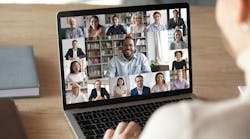The COVID-19 pandemic and the subsequent move to working from home is changing the way our workplaces will look, feel and function, according to experts from the design and research firm Gensler.
At IFMA’s virtual World Workplace 2020 conference, a team from Gensler revealed the findings from research conducted in summer and fall 2020, which revealed several emerging trends that affect the future design of workplaces.
“2020 has been a year where we’ve seen a fundamental shift in how and where work happens,” explains Janet Pogue McLaurin, principal and global workplace research leader for Gensler. “It’s accelerated a number of the workplace trends that we saw starting to happen even before the pandemic—things like mobility, choice, health and wellbeing. The longer we work remotely, the more it shapes not only how we work, but the future expectations for the office.”
Here are six ways Gensler sees the future workplace evolving in response to the prolonged work-from-home period.
1. Offices will have to redefine what work is and where work takes place. Organizations will have to become more dynamic and responsive to disruptive events, says Arnold Levin, leader of Gensler’s Southwest regional consulting practice. The organizations that respond most effectively to disruptions will be the organizations that have more dynamic organizational models.
“It’s going to be contingent upon organizations to move away from a very static and hierarchical business model to one that’s more agile,” Levin says. “Organizations able to work best over the past eight months in terms of working virtually not only had the right technology, but also had a business model that allowed them to be more permeable and agile in making decisions.”
2. The definition of employee experience is expanding. It’s easy to think of the employee experience as simply a collection of space types, but the shift toward hybrid offices where some people work from home and some people work from the office is expanding the definition of “the employee experience” into new realms, Levin explains. The definition of the workplace itself is changing, so the ways employees experience the workplace will too.
3. The concept of workplace culture will expand beyond the physical workspace. Company culture must become more human-centric in response to the COVID-19 pandemic, Levin says. Companies must actively create and maintain a constructive culture rather than leaving it to chance.
“One of the frustrations that most workers have had working virtually was the notion of loneliness, and how people feel part of an organization despite the fact that we’re all on Zoom now,” Levin explains. “The role of culture and focusing on the human portion of culture is going to become a lot more important to the business enterprise.”
4. Workplaces must prepare for and adapt to unplanned change. In Gensler’s summer/fall research, 52% of workers said they’d prefer to split their time between the office and home during a typical workweek, with only 19% saying they’d like to spend the whole week working from home. The workplaces of the future are likely to embrace a mix of remote and on-site work, so offices will have to adapt to that scenario, Levin says. Further, the needs of workers and the organization will change over time, and offices should be ready to adapt to ongoing change as well.
“The workplace will have to become more adaptable to continual change and evolution as we learn from the past and learn from the next couple of years going forward,” Levin adds.
5. Collaboration will look different. “Technology has shown we can work virtually and collaborate virtually,” says Levin. “How will we collaborate when we have people in the office physically in a hybrid model as well as working virtually?” It will be important to invest in systems that help people operate as a team rather than a constellation of individuals, Levin adds.
6. Measures of success must change. Strategies to motivate employees and track performance tend to favor efficiency over people, which can negatively impact long-term organizational success, Levin explains. Think about ways to incentivize and support employee engagement and how that might give rise to new performance measurements.
“In terms of the success of a project or organization in a hybrid work model, it begins to get measured in a very different way than most organizations have been comfortable with in the past,” Levin says.
Levin adds that how each organization embraces these broad trends will vary greatly. Each organization must consider how broader trends impact their own people and processes.
“Clients were beginning to ask us ‘What does this future look like? What will it look like when we come back to work?’” Levin says. “The straightforward answer is that we have no prediction as to what that will look like with certainty. There are a lot of different possibilities out there and a lot of it is based on the intrinsic and unique qualities of each organization. There’s not one solution for every organization out there.”
More from IFMA 2020:



